Illustrations of people and places of 19th century Caucasus now in National Archives of Georgia digital collection

Artist impressions of noblemen from the Western Georgian provinces of Samegrelo and Imereti by Imperial Russian administrator and painter Grigory Gagarin. Image via National Archives of Georgia.
A series of 19th century illustrations of people and places of the South Caucasus, published in a French magazine around 150 years ago, can now be viewed by those interested in history and ethnography on the website of the National Archives of Georgia.
Presenting city-dwellers and countryside folks of different ethnicities who lived and worked in cities, towns and villages, the works show Georgia and the wider region as it appeared to ethnographers and travellers between the 1840s and 1870s.
The sketches were made by people like Imperial Russian administrator and painter Grigory Gagarin, artists Louis Champoiseau and M. Philippovitz and others and published in L'Illustration Journal Universel, some of the historical editions of which are now preserved at the Tbilisi archive venue.

'View on Batumi', an illustration by Louis Champoiseau. Image via National Archives of Georgia.
Showing the appearance and attires of noble families, public servants and common residents of the region, the illustrations come with brief notes in French about ethnic and social identities of the persons featured.
Other sketches show sights of locations like the Fort of Shekvetili and the port city of Batumi on Western Georgia's Black Sea coast, places of worship for religious communities in capital Tbilisi, spaces of public gathering and workshops for crafts masters.
Views of the Caucasus Railway crossing Georgia in the West-East direction, construction of the now-major Black Sea Port of Poti, scenes of mobilisation of Imperial Russian army in the Russo-Turkish war of 1877-1878, and a gathering of Tbilisi youth in one of the city's gardens can all be seen in the drawings.
L'Illustration Journal Universel was published in Paris starting in 1843, with the weekly magazine publishing illustrations to accompany their articles about countries and people from around the world.
 Tweet
Tweet  Share
Share